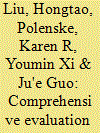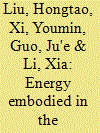| Srl | Item |
| 1 |
ID:
098689


|
|
|
|
|
| Publication |
2010.
|
| Summary/Abstract |
Greater use of renewable energy is being aggressively promoted to combat climate change by the Chinese government and by other governments. Agricultural straw is the kind of renewable energy source that would become a pollution source if it is not well utilized. We select the Shiliquan straw-based electricity generation project in Shandong Province, China as a case and assess environmental externalities of straw utilization in power plants by using life-cycle analysis. Results show that straw-based electricity generation has far fewer greenhouse gas (GHG) emissions than that of coal-based electricity generation. Improvement in the energy efficiency of equipment used for straw's pretreatment would lead to a decrease of GHG emissions and energy consumption in the life-cycle of straw-based electricity generation. In case 400 million tonnes of wasted straw in China could be used as a substitute for 200 million tonnes of coal, annually the straw 291 Terrawatt hours (TWh) of electricity could be generated, resulting in an annual total CO2 emissions savings of 193 million tonnes. Straw-based electricity generation could be a high-potential alternative for electricity generation as well as an incentive for utilizing wheat straw instead of burning it in the field.
|
|
|
|
|
|
|
|
|
|
|
|
|
|
|
|
| 2 |
ID:
097204


|
|
|
|
|
| Publication |
2010.
|
| Summary/Abstract |
Growing international trade has not only positively affected the People's Republic of China's (China's) economic development, but also expanded the exportation of energy embodied in goods during their production. This energy flow out will pose risks to China's rational utilization of natural resources as well as environmental protection. In this paper, we evaluate the energy embodied in goods produced in China during 1992-2005 and use input-output structural decomposition analysis to identify five key factors causing the changes of energy embodied in exports. (Direct primary energy efficiency, primary energy consumption structure, structure of intermediate inputs, structure of exports, and scale of exports.) For the three sub-periods of 1992-1997, 1997-2002, and 2002-2005, results show that China is a net exporter of energy, and the energy embodied in exports tends to increase over time. The expanding total volume of exports and increasing exports of energy-intensive goods tend to enlarge the energy embodied in exports within all three sub-periods, but these driving forces were offset by a considerable improvement of energy efficiency and changes in primary energy consumption structure from 1992 to 2002 and the effects of structure of intermediate input only in the sub-period from 1992 to 1997. From 2002 to 2005, the sharp augmentation of energy embodied in exports was driven by all the five factors. Our research has practical implications for the Chinese economy. Results of this study suggest that the energy embodied in trade should receive special attentions in energy policies design to limit the energy resource out-flow and pollution generation.
|
|
|
|
|
|
|
|
|
|
|
|
|
|
|
|